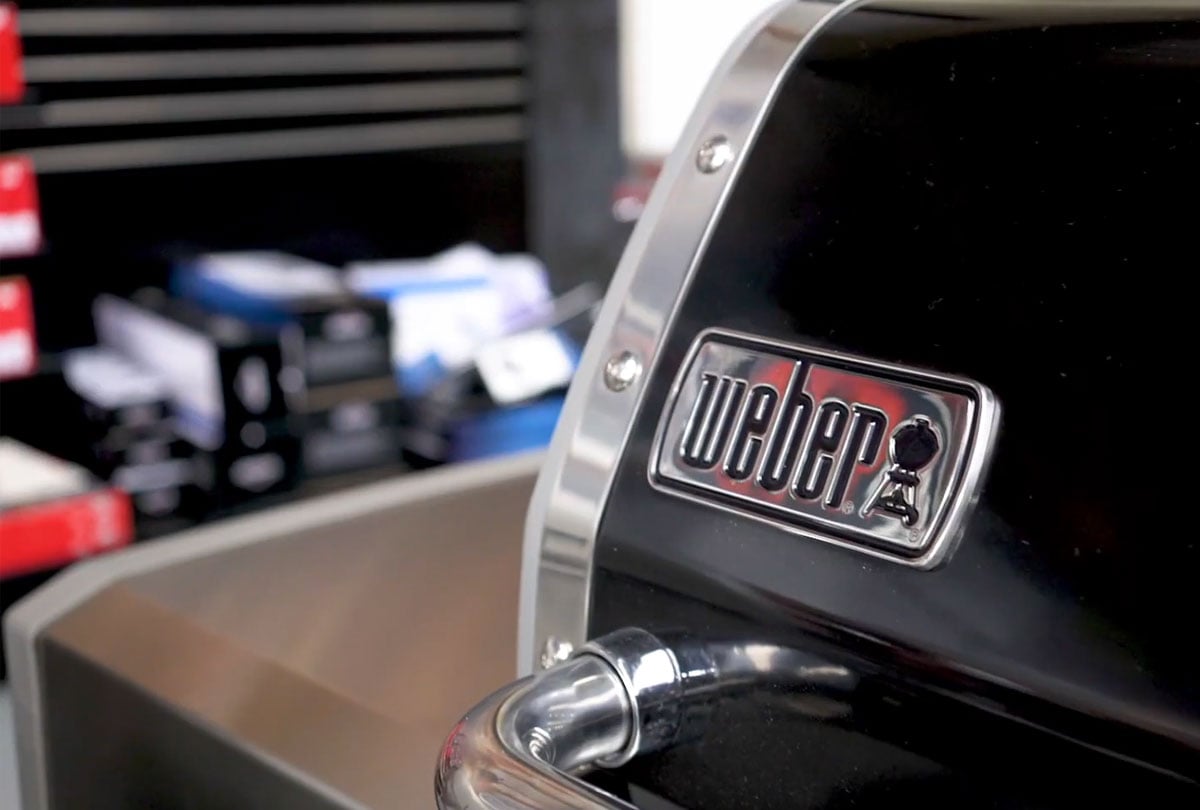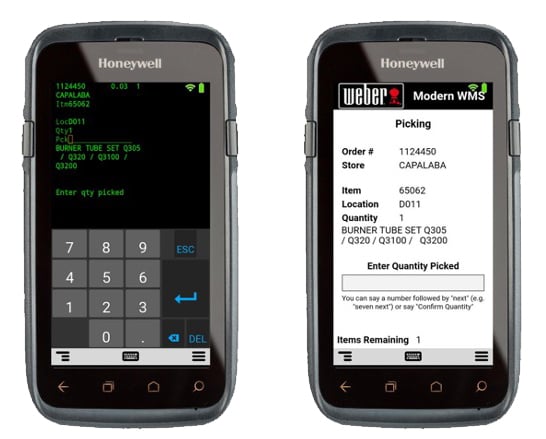Ivanti Velocity
Move Existing Telnet and Web Apps to Android, iOS and Windows 10, Risk-Free.

Weber tackles day-to-day supply chain challenges by adding voice recognition to their warehouse technology, increasing productivity and providing a safer workplace.
There is no bigger name in the home grill market than Weber. Being one of the largest brands in the industry, day-to-day challenges in the Weber supply chain will inevitably develop — managing stock movements, maintaining visibility of what is where, and keeping staff safe and on track with product picking.
It was in the land down under — Adelaide, Australia — where the Weber head office tackled these challenges head-on. What ensued was a transformation of their warehouse technology that not only increased productivity but provided a safer workplace by implementing the power of voice.
Business challenges come in different forms, some customer-facing while others internal. Weber customers have always experienced high service levels, but maintaining these experiences is predicated on the processes employed within the business.
Fortunately, the processes within Weber’s warehouse were already underpinned by the use of technology. Weber in Australia were using mobile-computing technology to manage the day-to-day warehouse tasks such as product put away and order picking. The devices proved to be a great tool for staff, but some challenges with their use were observed by their logistics manager, and other external issues loomed.
It was noticed that the number of key clicks required on their rugged barcode scanners to process a transaction was considerable. This not only consumed valuable time but was a safety concern as the staff were being distracted by the amount of time working with the device.
The Weber business involves handling bulky items that require two-handed picking which cannot be achieved with a device in hand. A further productivity and safety issue was identified as a result of the need to move the mobile device out of the workers’ hands to allow them to pick goods effectively. In addition, the mobile devices in use were approaching their end of life due to the operating system becoming unsupported. This posed a further challenge to the continuity of processes over time with the existing technology employed.
While these challenges were being faced, another was rising. The COVID-19 pandemic had hit in early 2020 and with it came a shift for the Weber business. With lockdowns in place, the business offered free shipping for online orders. This increased sales and pressure on the warehouse to be more productive.

Old vs New. The migration process using Ivanti Velocity modernised screens without one line of code being written.
Now that the Weber application was working on the Ivanti Velocity platform, Weber was able to add voice to their processes, a technology they had only been considering months prior but without an effective solution in mind. The ability to add voice meant that warehouse staff no longer needed to physically interact with their mobile device. They were now able to rely on voice commands and acknowledgment.
Fortunately, the team at Weber is forward-thinking and stays abreast of the latest technology available in the supply chain. Technology such as robotics, AI and voice solutions were all being monitored for their application benefits for Weber, but the immediate need was to replace the existing mobile devices.
Unbeknown to Weber, this first step opened the door to solve some of the supply-chain challenges they were facing. Logistics Manager, Terry Garner, contacted their mobile-device supplier, Intermax, to enquire about procuring new mobile devices for use in their warehouse. The team at Intermax explained that now was the time to move to an Android-based mobile device. Not only would this solve the issue of the end of support for the operating system used on Weber’s now defunct devices, but it would unlock functionality that could address some of the further challenges being experienced in the warehouse.
The decision to move to Android was a simple one for Weber, with the Honeywell CT40 mobile device being chosen after a proof of concept was completed. The modernisation of Weber’s supply chain practices was now unlocked with the help of Intermax.
The first hurdle was to migrate Weber’s mobile app to the Android operating system. This was achieved with the help of Intermax by using the Ivanti® Velocity migration platform. This platform enables easy transformation of older, green screen-based applications to a modern, touch-enabled layout on the Android operating system without a line of code being written. The Ivanti solution meant that the adoption of the new devices within the Weber warehouse could happen in days rather than months.
Application screens were progressively migrated and modernised by Intermax for greater useability. No more green-screen applications, rather a full-colour, intuitive, touch-enabled experience. Straight away processes could be streamlined in the application to reduce the number of keystrokes, but it was the next step that transformed Weber’s warehouse practices and unlocked productivity and safety gains.
Warehouse staff were now being guided by voice for all product-put away and picking in the busiest section of Weber’s warehouse — their ecommerce spare parts and accessories division.
Rather than staff having to hold their device in their hand to read what orders had to be picked and then record activity via a touch-based interface, the mobile device could now be placed in a waist-mounted holster. Coupled with a Blue Parrot C400XT headset employed to listen and respond to commands being given, staff were now working handsfree. Moving to a handsfree operation solved the safety concerns of managers when handheld operation was in use. In addition, with less handling of the mobile device, staff could now undertake their tasks at a faster pace allowing for significant productivity gains.
The speed in which this new technology could be adopted was critical due to the fact that heightened online sales — a result of the COVID-19 pandemic — was placing pressure on the supply chain. A traditional voice solution is cumbersome to implement, requiring additional server hardware onsite and configuration.
The Ivanti Velocity Voice solution, which sits on the Ivanti Velocity platform, is a web- based application that does not need any specific hardware or cumbersome setup. Not only is the solution vastly more cost effective, allowing for easier adoption of voice-based workflows, Weber was able to move to voice within two weeks of moving to the new mobile devices, a concept unheard of with other solutions.
With the COVID-19 pandemic in full swing, implementation of a new technology platform may have been viewed as a challenge. In reality, the entire solution was implemented remotely. Not only were the configuration of new Android mobile devices and the modernisation of the application screens done remotely, so too was the voice component. The speed of delivery of the Ivanti solution meant that the ROI on the technology was being realised far sooner.
The shift to voice-based processes happened quickly in the Weber warehouse, but to ease the challenge of adoption by the workers, a staged approach was taken.
Initially, voice was used for small functions within the warehouse before a broader rollout. With some hesitancy by staff to adapt to the new way of working, it was within three to four weeks of the initial voice rollout that the team had embraced the voice solution — and they have not looked back. The combination of more usable and streamlined application screens, upgraded mobile hardware, and voice has made life for the on-the-ground worker a lot easier.
“Shifting to voice-based processes in the warehouse at Weber has created a significant impact,” said Terry Garner, the Weber Logistics Manager for Australia and New Zealand. “We have experienced a 12-second reduction in the time to pick an item. In product-picking numbers, that equates to time savings of 20 minutes for every 100 items picked, representing a significant boost in productivity, especially given that the Weber Australia operation picks approximately 600 items a day. With the new voice solution in place, we have been able to save a massive two hours a day in picking time. With such productivity gains, customers’ expectations are met, even with an increase in demand.”
A reduction in potential safety issues was achieved as a result of moving to handsfree operation of the mobile device and less time physically interacting with it. The demand in the warehouse increased significantly during the COVID-19 pandemic, which resulted in additional staff needed, but less staff were recruited due to the productivity gains of the voice solution. Fewer workers doing more has significantly enabled the Weber operation in Australia to manage the peaks of demand while also keeping operational costs low.
In order to keep up with demand, Weber in Australia has increased their warehouse space from 600sqm to 2500sqm. The new technology implemented in the warehouse has supported the growth effectively and will enable further process enhancements as a result of working on the Ivanti Velocity platform.
The Weber business in Australia and New Zealand is going from strength to strength and this is greatly supported by a management team that isn’t afraid to look at new technology and invest in it.
The decision to upgrade to Android mobile devices, work with the Ivanti Velocity platform, and adopt voice in the warehouse has truly unlocked future process refinement of their supply chain — and all this done in a cost-effective way and implemented in weeks rather than months.
Staff are more productive and safer. Managers have greater visibility and accuracy around stock movements. It’s easier for Weber to onboard new warehouse staff with the more intuitive applications in place. Above all, Weber customers’ expectations are being met, even when the demand for Weber products has increased.
What started as a common need to update mobile devices has resulted in a streamlining of warehouse processes that use the power and simplicity of voice and unlock productivity gains in the Weber supply chain.
It’s truly an all-round win for all involved.
Note: A customer’s results are specific to its total environment/experience, of which Ivanti is a part. Individual results may vary based on each customer’s unique environment.